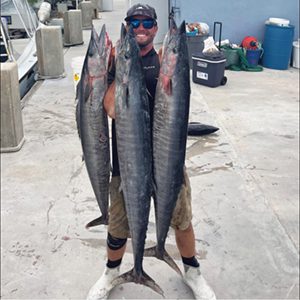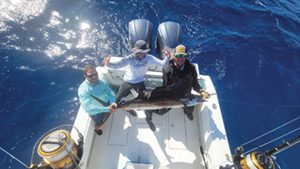
The weather will deal the fishing cards your play during February. Cold fronts or unseasonably warm temperatures dictate which fishery will present the best action. Sailfish like the cold fronts. On the other hand, warmer temperatures are conducive to good fishing for king mackerel, dolphin and all the reef species.
We’ve had a steady run of sailfish off the reef edge, and there are good numbers of blackfin tuna mixed in where we’re finding the sails. January gave us some excellent wahoo fishing, which should spill into February with the presence of larger fish in the 30- to 50-pound category that tend to show up in the winter.
Most of this action has been on live bait, primarily pilchards and cigar minnows. The wahoo respond to goggle eyes or small bluerunners fished down 50 to 80 feet while you’re live-baiting for sails and tunas on top.
Around the wrecks and artificial reefs, there’s been lots of king mackerel action, with fish averaging 10 to 20 pounds and some approaching 40. On or near the same wrecks, you’ll find amberjacks, mutton snappers and big yellowjacks on the bottom.
Live pilchards, ballyhoo and cigar minnows are the prime baits for wreck fishing. There’s been loads of action on yellowtail snappers on the reef, but you need to keep your eye on the weather this time of year. Don’t bother yellowtailing just after a cold front. Rather, wait a couple of days for the weather to stabilize and the temps to warm up, which will spur on the yellowtail bite.

Hawk Channel is always a winter go-to. There have been lots of lane snappers as well as surprisingly good-size yellowtails in the 3- to 15-inch range. Muttons are there too and, although the majority are just shy of keeper size, there are enough 18-plus-inch fish to hold your interest. We’ve even had some beast 10-pounders make their way onto our boats.
Shrimp or small pilchards on a half-ounce jighead work best in Hawk Channel. If you begin to get bit off, put a small shot of #4 wire on and have fun with Spanish and cero mackerel. When the conditions are exactly right, you may catch kings up to 30 pounds.
In the Gulf and Florida Bay, you can expect good fishing during February.
We’ve recently seen some of the best fishing in these areas in quite some time, with loads of bait, including threadfin herring and ballyhoo, prevalent on the Gulf wrecks plus more ballyhoo around the banks and grassy areas of Florida Bay. These bait fish attract predators of all kinds, but the two most important to us are king mackerel and cobia.
The kings back here are typically quite large, starting at about 20 pounds and with 50- and 60-pounders common. Large baits are required to gain their attention. Everything from large threadfin herring and pilchards to bluerunners and blue fish in the two-pound class make excellent baits for large kings. Put one of these baits on a kite and get ready for some high-flying king mackerel action. Bigger baits require a two-hook rig, which we custom-make according to the size of the bait fish.
You’ll also find Goliath grouper of all sizes in the same areas as well as mangrove and lane snappers. For the snappers, use small live baits, such as pilchards, small pinfish or fresh shrimp as well as chunks of ballyhoo or pinfish. Fish the bait on or near the bottom with a knocker rig or 3/8- to half-ounce jighead.
Round out your Florida Bay fishing with Spanish mackerel for the smoker. Small bucktails or jig heads tipped with fresh shrimp work best.
— Capt. Chris Johnson | SeaSquaredCharters.com | 305-393-2929
Facebook.com/MarathonFishing | Marathon Florida Keys
